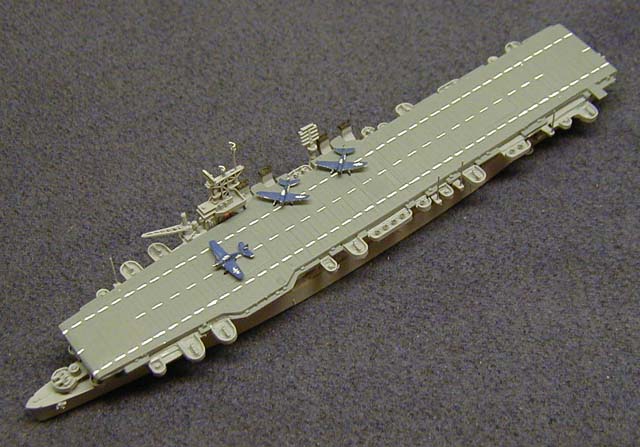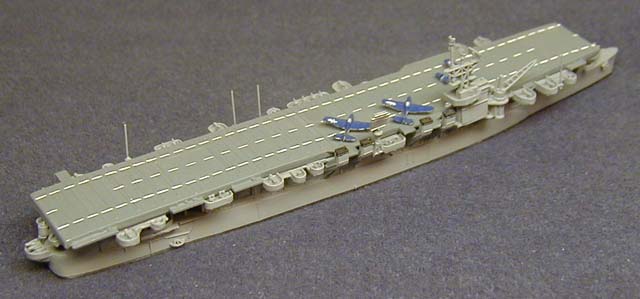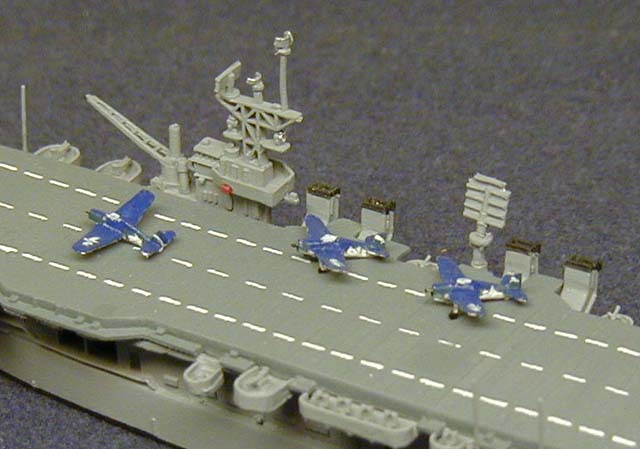U.S.S. Independence
CVL-22

1943
(Neptun 1311)
- Class: Independence - 9 light aircraft carriers of 1940-42
- Displacement: 11,000 tons
- Dimensions: 600(wl) 622.5(oa) x 71.5 x 26 ft.
- Machinery: 4-shaft geared turbines, S.H.P. 100,000 = 31.6 knots
- Armament: 26-40mm (2x4,9x2) A.A. guns
- Aircraft: 45
- Complement: 1,560
- Builder: New York Shipbuilding Corp, Camden NJ
- Keel Laid: 1 May 1941
- Launched: 22 Aug 1942
- Commissioned: 14 Jan 1943
- Decommissioned: 28 Aug 1946
- Notes: President Roosevelt, concerned about the long wait until Essex-class carriers would start to be delivered, directed the conversion of one light cruiser to a light aircraft carrier on 2 Jan 1942. The Independence had been laid down as the Cleveland-class light cruiser Amsterdam (CL-59). She was reordered as a light aircraft carrier 10 Jan 1942 when 39.5% complete and commissioned as CV-22, a designation later changed to CVL-22 in Jul 1943. Two additional conversions were ordered on 10 Feb 1942 of ships already under construction: Tallahassee (CL-61) became Princeton (CVL-23) and New Haven (CL-76) became Belleau Wood (CVL-24). Three more conversions were ordered on 27 Mar and three additional on 4 Jun 1942. All nine light carriers were commissioned by the end of 1943.
Independence was completed with open-mount 5" guns at bow and stern; these were soon replaced by quad 40mm mounts, and all subsequent members of the class were completed that way. Aircraft groups initially included F6F fighters, SBD dive bombers, and TBF torpedo planes. However, the non-folding wings of the SBD's caused storage problems with the small hangar and standard complement eventually became 24 F6F and 9 TBF, although more could be carried.
- Action: Independence joined the Pacific Fleet in Jul 1943. She participated in raids on Marcus, Wake, Bougainville and Rabaul. While supporting the landings on Tarawa in the Gilbert Islands, she was severely damaged by an aerial torpedo 20 Nov 1943, Repairs and an extensive refit kept her away from the Battle of the Philippine Sea, where all eight of her sisters fought. After training as the first "night carrier", she rejoined the fleet in Jul 1944 and took part in operations at Palau, Leyte Gulf, Iwo Jima, and Okinawa
After the Japanese surrender, Independence participated in Operation Magic Carpet, transporting returning servicemen to the U.S. In 1946, she was chosen as a target for Operations Crossroads, the atomic bomb tests at Bikini Atoll in the Marshall Islands. She suffered only minor damage in the first test - the air drop of 1 Jul. However, her flight deck was wrecked in the second test - the underwater explosion of 25 Jul. She was towed first to Kwajalein, then Pearl Harbor and later San Francisco, where her radioactive hull was used for weapons trials. She was finally sunk as a target off the California coast, 29 Jan 1951.



 Previous
Previous
 Up
Up
 Next
Next





 Previous
Previous
 Up
Up
 Next
Next